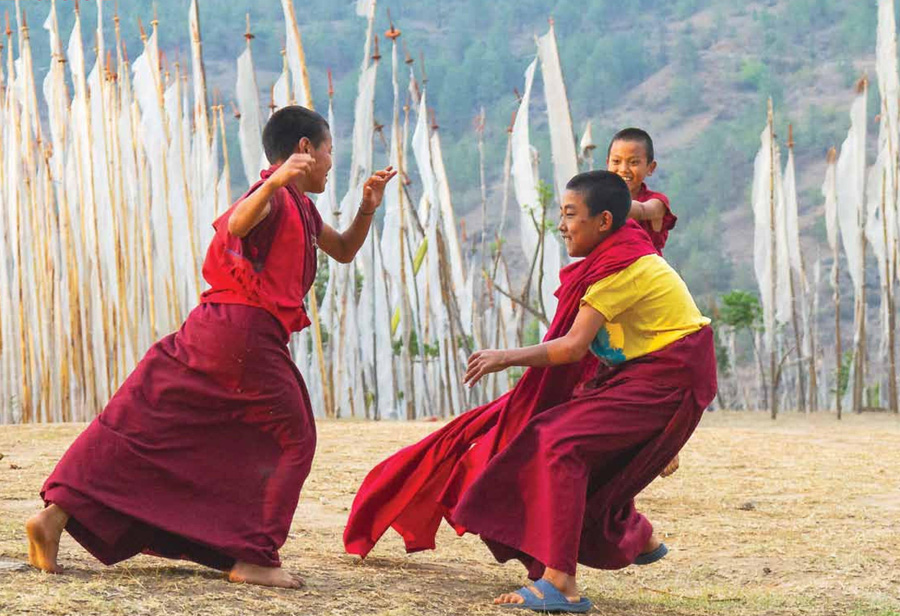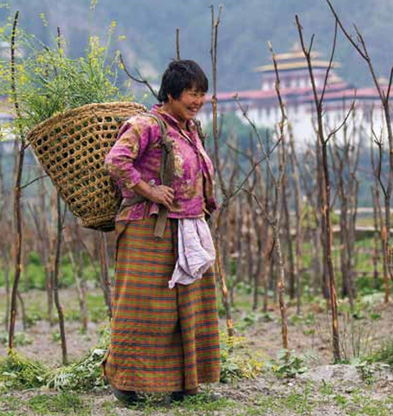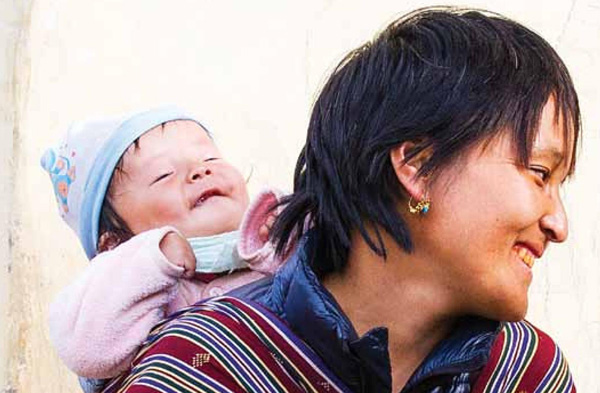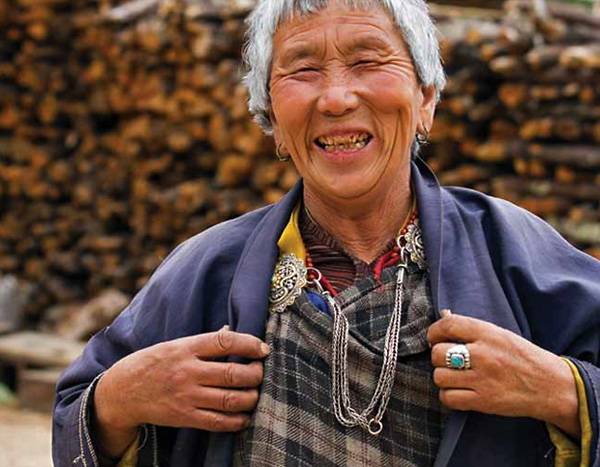+ This article was written by Dr.Hiren Shah, who travelled with Darter Photography on the photography tour to Bhutan. This story and images were first published by a travel magazine.
+ See more about our next photography tour to Bhutan, scheduled for May 2015.
Che namay samay jarim dhu! Tshering Norbu started blushing at my compliment. Wangdi, my guide, had translated it in Dzonka, the language prevalent in Bhutan, and it meant “you look handsome”. Tshering was a young monk, studying in a monastic college in Paro, Bhutan. I met him on my penultimate day in this Himalayan Kingdom. For one week I had been travelling to different places in Western Bhutan and during my journeys, I came across many local people, as cheerful and happy like the coy Tshering.
Recalling those faces, I requested Wangdi to translate my next question: “Why are people so happy here?” This time Tshering laughed, although with a look of amazement. Maybe he was never asked such a question, or perhaps, he had never seen otherwise.
Upon asking the same question to other students in Sang Choukhor Buddhist Institute, the response was not much different. The contentment and happiness was palpable in the people of Bhutan and their conversations. It reflected in their expressions and radiated from their faces. Yet, I could find a satisfactory answer for reason behind it. I was keen to find it. As if seeking enlightenment in this Buddhist land, I was in search of the reason for their happiness!
Bhutan, a tiny country, landlocked between India and China, is by and large an agrarian society. Majority of the people depend on the farms and cattle for their livelihood. While driving at the outskirts of Paro, I stopped at one such field where women were singing while preparing the soil for the coming monsoon season. They were quite friendly and on my request, they allowed me to click their pictures. Their singing eventually turned into loud chatting with intermittent giggles. Were they amused by my odd postures and frantic efforts to compose their happy laughing faces in the frame of majestic Paro Dzong (monastery) in the background? Whatever may be reason for their mirth, but they were the prototype of an average Bhutanese, who breathes happiness, day in and out.
Paro Dzong, with its massive buttressed walls, towers over the town and is visible throughout the Paro Valley. It is one of the finest examples of Bhutanese architecture. That takes some saying as Bhutan is home to some of the most exquisite monasteries in the world. All these prominently striking landmarks along with unique artworks and religious elements like prayer wheels and prayer flags, in the midst of natural beauty of mountains, create a strong impact on the day-to-day life of people and evoke a strong sense of uniqueness and pride. This may be the one of the vital elixirs for their happiness.
Like Paro Dzong, Taksang Monastery is another example of classic temple architecture and also the most photographed edifice in Bhutan. This temple, also known as Tiger’s Nest, is on a narrow ledge in the middle of a steep cliff, about 10,000 feet above the sea level. For me, the ascent of roughly 3,000 feet from the floor of the valley was quite a strenuous trek. It took me about three hours to reach the Tiger’s Nest. Every single step through the pine jungle, with the splendid monastery playing hide and seek through the coloured prayer flags, was worth the effort. I was the happiest person when I reached the top. The endorphins released after such an exercise added to the spectacular view. On the other hand, the hard working native of this mountain country scales such heights in no time. No wonder, he is healthy and happy!
I also had an opportunity to witness a funeral in the backyards of Kyichu Lhakhang, one of the oldest monasteries in Bhutan. Here the monks were conducting the rituals. The monks play an important role in the various religious ceremonies during events like birth, death, marriage, or illness in the life of an average Bhutanese. Till the introduction of modern education, mobrnasteries were the only centres of learning. The ultimate purpose was spiritual progress and proficiency in Buddhism. Scientific studies have proven a strong link between religious practices and spiritual engagement and mental wellbeing and happiness!

I visited Chimi Lhakhang, a small but well-known temple in Punakha district. By evening all the ritual activities were over and most of the visitors had departed. The young boys, who were learning to become monks, came out in the open space ‘to let their hair loose’. The phrase may not fit well for their shorthaired heads, but one needs to be there to believe the impish and mischievous trait of these future monks. The aura of happiness, along with the knowledge, wisdom and philosophy they will gain, will be disseminated to the masses in the future.
Before reaching here, I’d already ‘googled’ that Bhutan was rated as the happiest country in Asia, and ranks eighth in the world. In Bhutan, Gross National Happiness is an official development policy that is more important than the Gross National Product. The concept implies that sustainable development should take a holistic approach towards notions of progress and give equal importance to non-economic aspects of wellbeing. And now, as my tour was progressing, I was gradually getting convinced about my ‘search’ results. These happy faces were not masked for sure, but I was still in search of a complete answer.
One morning in Punakha, while going to Khansum Yulley Namgyal Chorten, I met a young mother carrying her baby tied to her back. She was crossing a suspension bridge on her way to the work. With a phone in one hand, and trying to converse in broken English sentences, I saw in her a classic example of the modern-day woman in Bhutan. I also had chance to interact with waitresses, receptionists, students and village dwellers. I realised that they enjoy equal status and rights with men, politically, socially and economically. Needless to say that women here are also happy!
It was a great sight to see these people clad in their national dress. Men wear knee-length robe tied with a belt, called a gho, while women wear ankle-length wrap with a coloured blouse, known as a kira. It was worn by everyone, right from the driver of our van, Karma Dorji, the bookshop keeper in Thimphu, Sonam Yeshi, to the manager in the Drukchen Hotel, Jigme Chogyal. I believe this uniformity added to their national integrity. Apart from the costume, the Bhutanese culture has also been expressed in their customs. Similarly, language and literature, signs and symbols, dance and sports, faith and superstition also add to the list of their cultural expressions. These cultural norms give the people their unique identity and binds them as a nation. This seems to be yet another key to their happiness.
Another could be the varies aromas that one encounters here. Still lingering in my nostrils is the smell of alpine flowers in the mountains, the fragrance of incense sticks in the monasteries and chortens, and the aroma of spices from the kitchens. The palate is still bursting with the taste of sharp ema datshi(popular side dish of chilly and cheese), nutty red rice and sour sud-ja (butter tea). I still hear the whisteling sound of the wind through prayer flags at Chela La (pass), whooshing of arrows at archery grounds of Thimphu, and the drum beats during Tshechu (traditional masked dance). I still vividly remember the touch of the sacred prayer beads, soft rhododendrons in the country side and icy-cold water cascading from the cliffs. And how can I forget the sights of hundreds of stupas wrapped in mist at Dochula, purple Jacaranda trees in full blossom in front of Punakha Dzong, glowing face of the orange-robed monk lighting a butter lamp in the prayer hall, a doma (areca nut)-chewing woman flaunting her jewellery in Haa village and the innocent eyes of a young girl standing at the window in Thimphu. The list is endless!
As varied experiences of this eight-day travel flood in, I feel a deep overwhelming sensation. I came across several faces, each one raising the question, “Why are people so happy here?” I am tempted to conclude that all these stunning stimulations, summated with unique untouched culture, good governance and a strong sense of national identity is what perhaps bring out the happiness on the face of a Bhutanese.
Even after Druk Air’s twin turboprop took off from the Land of Dragon for Kolkata, just as the enthralling vistas of mighty Himalayan peaks rolled in behind the clouds, I found my thoughts too clouded with dozens of images of those happy faces with gleeful eyes and giggling grimaces, with riotous revelry and roaring rapture. As I buckled up into my seat, feeling truly happy, I gazed out of the window for one last look and wondered–as a pediatrician–if the newborns in Bhutan cry immediately after birth or open up their lungs with a burst of laughter? Perhaps, happiness is not considered just a state of mind but also a way of life in Bhutan.
+ See more about our next photography tour to Bhutan, scheduled for May 2015.




